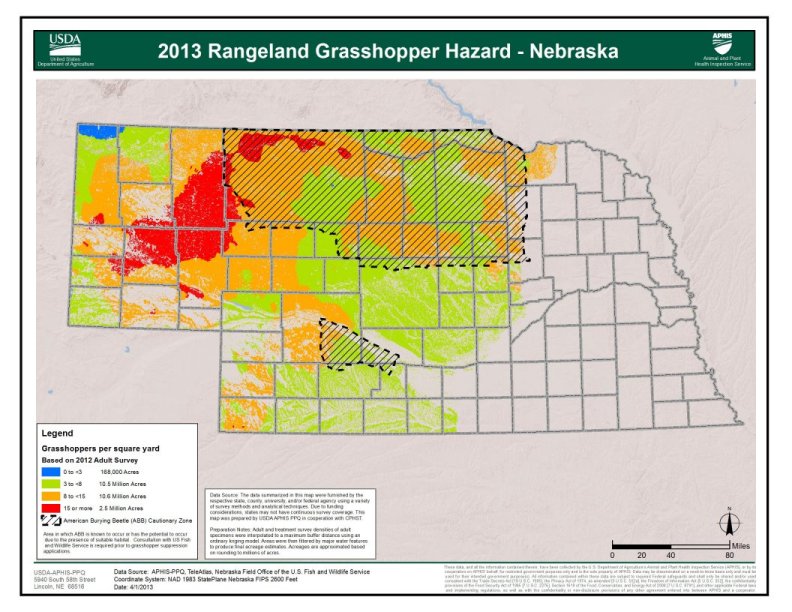
By Bethany Johnston, UNL Extension Educator
Sunny weather, warm soil, spring is here! With the arrival of spring also comes the hatching of grasshoppers. Some areas of Nebraska are at high risk for serious grasshopper infestations this year, based on the 2012 fall adult grasshopper surveys conducted by the Animal Plant Health Inspection Service (APHIS). The number of adult grasshoppers last year is an indicator of the number of eggs laid in the fall, which is the overwintering stage of most grasshopper species. Due to this potential threat, ranchers and landowners of rangeland in these high risk areas should be prepared to monitor the possible build-up of grasshoppers during May and June.
Not sure if grasshoppers are a potential problem? Check out the UNL Grasshopper website at http://entomology.unl.edu/grasshoppers/. Scroll down to Nebraska Rangeland Grasshopper Hazard Map 2013 or click here http://go.unl.edu/d48. Red areas are counts over 15 grasshoppers per square yard.
In the next month, ranchers should start watching for nymphs, or baby grasshoppers. For the most bang for your buck, insecticides usually should be applied around the second week of June, when grasshoppers are in the 3rd instar, before they develop wings. If the grasshoppers are flying, you are TOO LATE to spray.
Who has time to spray grasshoppers when producers are busy with calving, planting, brandings, and turning out to pasture? If grasshopper counts are large enough, you do! Grasshoppers eat 100% of their body weight, so an acre with 18 grasshoppers/square yard is equal to increasing the stocking rate by 50%. Combine that with drought, and you will be running out of grass fast.
If a large area is infested, farmers and ranchers can set up large blocks to spray that helps reduce aerial application costs. Knowing when to spray (what instar the grasshoppers are) and what to spray (Dimilin is very effective, but some counties cannot spray due to the presence of the endangered American Burying Beetle) are key.
Dave Boxler, UNL Entomology Educator, has worked with and researched grasshoppers for years. “Knowing when and what to spray is critical,” says Boxler. He recalls a producer with high grasshopper counts who wanted to spray in June. However, after surveying the numbers and nymph stage in April, Boxler discovered they were working with a whole different species. Bandwings were predominant and bandwings overwinter as nymphs. If the producer would have waited to spray in June, the bandwings would have been mature. Time, pesticide, and money would have been wasted. Instead, the producer was able to spray in April and reduce grasshopper numbers.
If landowners or livestock producers are considering applying an insecticide to control grasshoppers and might be close to the American Burying Beetle Cautionary Zone, they need to check the label of the product they plan to apply, more than likely the insecticide label will direct the person to the Web Site “ Bulletins Live,” http://www.epa.gov/espp/bulletins.htm. You are required to follow the pesticide use limitations found in the Bulletin for your county, pesticide active ingredient, and application month. The EPA’s Bulletins contain the following information:
▪ Map of the county to which it applies
▪ Description of the species being protected
▪ Pesticide(s) of concern
▪ Pesticide use limitations
▪ Month for which the Bulletin is valid
Look down and be on the lookout for tiny grasshoppers. For more information, contact Dave Boxler at 308-696-6721 or visit the UNL Grasshopper website at http://entomology.unl.edu/grasshoppers/.
NebGuides with more detail are also available:
▪ Grasshopper Identification Guide for Rangeland and Pasture - Summer Feeding Species, EC1568 (http://www.ianrpubs.unl.edu/sendIt/ec1568.pdf)
▪ A Guide to Grasshopper Control on Rangeland, G1630 (http://www.ianrpubs.unl.edu/sendIt/g1630.pdf)
▪ A Guide to Grasshopper Control in Cropland, G1627 (http://www.ianrpubs.unl.edu/sendIt/g1627.pdf)
▪ A Guide to Grasshopper Control in Yards and Gardens, G1633 (http://www.ianrpubs.unl.edu/sendIt/g1633.pdf)